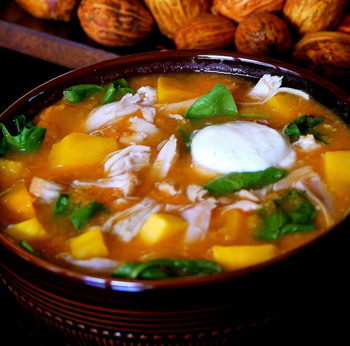 This soup, along with a green salad and some nice bread, is a great dinner for a chilly night. This soup is loaded with sausage, beans and ditalini pasta. It's really a pretty traditional "Pasta e Fagioli" soup, but with sausage. I've made the soup with turkey sausage, but you can use any sausage you like.
This soup, along with a green salad and some nice bread, is a great dinner for a chilly night. This soup is loaded with sausage, beans and ditalini pasta. It's really a pretty traditional "Pasta e Fagioli" soup, but with sausage. I've made the soup with turkey sausage, but you can use any sausage you like.
I've used dried beans to make the soup. You can certainly use canned, but if you've never cooked with dried beans, you should try it. Some people are confused about dried beans and don't know how to soak them and cook them. But there really is no mystery to it at all – it's very easy. Soaking simply softens the beans so that they have a shorter cooking time. That's all.
And you don't really even have to soak them. If you forget to soak them, simply cook them longer. I just throw the beans in a pot and cover them with water and let them soak all day. I drain them, add fresh water and then cook them until they are tender. That's it.

 Eggplant is a delicious and versatile fruit. Yes, eggplant, a member of the nightshade family with tomatoes and potatoes, is technically a berry. There are several different varieties of eggplant, some long, narrow and pale purple, some small, white and egg-shaped (do ya think that’s where the name came from?), some yellow, some striped and of course there is the large purpley-black globes that are the most common. I grew two varieties of eggplant this year, and while successful, the plants did not produce enough fruit to keep up with my appetite.
Eggplant is a delicious and versatile fruit. Yes, eggplant, a member of the nightshade family with tomatoes and potatoes, is technically a berry. There are several different varieties of eggplant, some long, narrow and pale purple, some small, white and egg-shaped (do ya think that’s where the name came from?), some yellow, some striped and of course there is the large purpley-black globes that are the most common. I grew two varieties of eggplant this year, and while successful, the plants did not produce enough fruit to keep up with my appetite.  The other day at the market, a woman approached me and said, "Excuse me, but may I ask you a question?"
The other day at the market, a woman approached me and said, "Excuse me, but may I ask you a question?" As each new season arrives I begin to think that it's my favorite. The colors, the scents, and the flavors of fall are just beginning to tantalize my senses. For sure it's the rich and eye-catching colors that grab me first; the pumpkins, pomegranates, pears and apples are so beautiful they almost beg to be put on display.
As each new season arrives I begin to think that it's my favorite. The colors, the scents, and the flavors of fall are just beginning to tantalize my senses. For sure it's the rich and eye-catching colors that grab me first; the pumpkins, pomegranates, pears and apples are so beautiful they almost beg to be put on display. It is a little known fact that I can speak Japanese. True, I only know two words, but I say them well.
It is a little known fact that I can speak Japanese. True, I only know two words, but I say them well.